Do contemporary subcultures replace folklore in our globalized world?
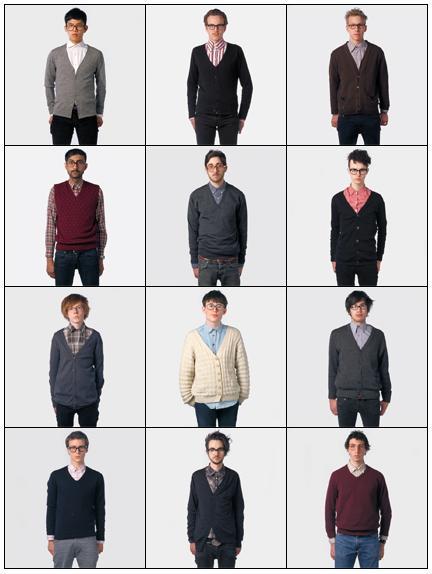
The dutch company VLISCO is producing batik fabrics all of us immediately regard as authentic african. Researching on this one is forced to concern oneself with the peculiar situation of interweaved, imposed and inherited cultural identities.
How does it fit to our stereotype that this fabric, which became such a strong symbol for the celebration of postcolonial independency is actually designd by the dutch? The path opened by this little question leads far. Where do our strereotypes come from? To which extent is cultur original? What do we build our identities out of? What do we regard as typical african, what as european? How do we deal in the postcolonial age with our guilt for colonial crimes?
My research is in particular focusing on „the swing“ made by the british-nigerian artist Yinka Shonibare, who is using the dutch wax as a kind of trademark in his work and somehow seems to be related to all questions mentioned above.
Myrza de Muynck is a Dutch textile artist. She’s not that known and quite invisible on the Internet.
The one and only source of information about Myrza is presented by the ‘APPALACHIAN SCHOOL’.? She was part of their second big group exhibition in the summer of 2007. As a journey to the exhibition, the artists were invited to use the ‘Appalachian Review’. This is an online publication, which invites artists to submit a portfolio of work in progress, to be exhibited.
The portfolio of Myrza contains ten pieces. Like sketches and inspiration. My approach for this research will continue this. I’ll search for the background information from the people that inspired her for this exhibition and try to interpret this in her personal work. Trying to find out this person, Myrza de Muynck.
A lot of “rules” were written for architecture. Not always have they been followed up and also a lot of times they have been discussed by other “writers (philosophers)” / architects.
Adolf Loos was one of these architects who were more philosopher than architect. Even though the whole world listened to what he had to say, his rules were not followed by everyone and not as strict as he had hoped for. This is due to the fact that there were more of these men that had their ideas about architecture. Besides the Ornament & Crime essay there were serveral others like the “Raumplan”, “the Plan Libre” and peoples individual ideas.
Today we don’t design according to a “manual” written by one architect. There are thousands of manuals that inspire us. It’s about what we want ourselves.
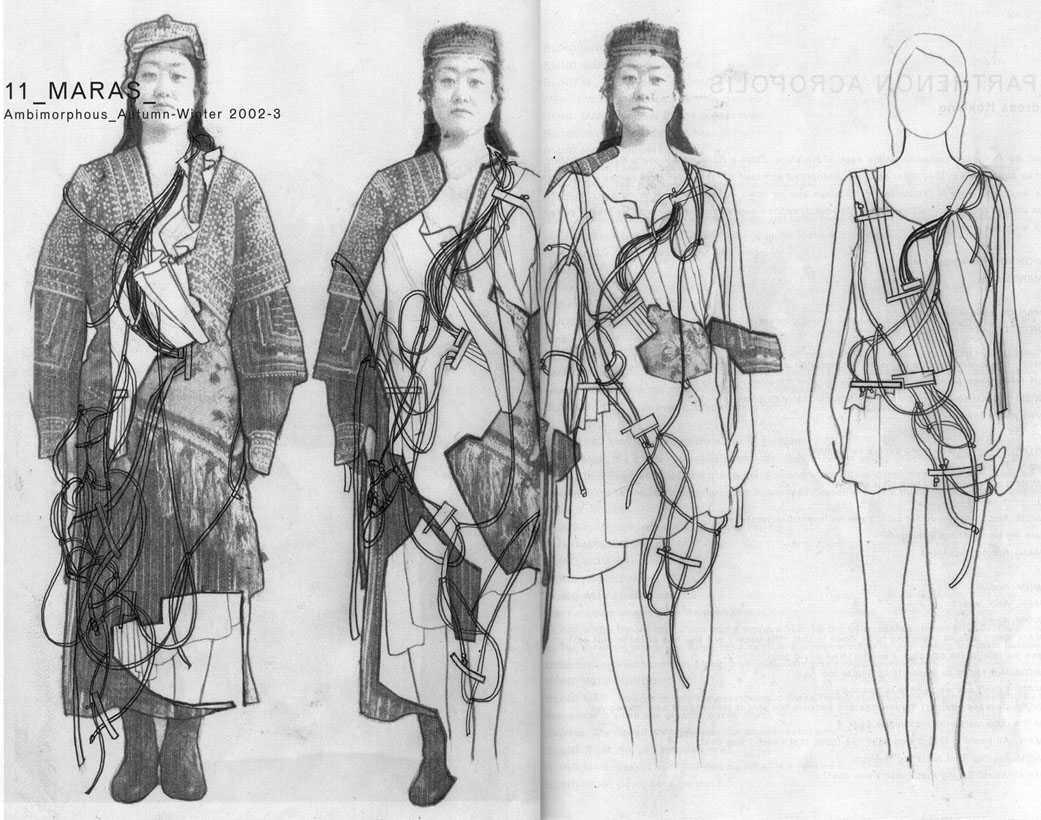
Clothes are ultimate symbol of the culture. It’s a reference point, a language of people, a language of territories.
The growing of technology affects notions like identity, mobility, displacement and migration They are parts of Hussein Chalayan’s work, and of our daily life too.
Many of us are foreign, from where are we coming from, how are we going to integrated this new folklore with our, this new environment where we are living now?
Here some examples, based on the work of Hussein Chalayan through the question: How technologies and displacement of people can change the folklore today?
Can we talk now about a construction of a bicultural folklore? or a multicultural folklore?
What are we losing, what are we creating new?
Can we say that we still need some reference points?
Willemijn de Greef seems to have been interested in the subject “folklore” since she was making her end exam show at the Rietveld academy in 2006. She also seems to be inspired by fishing industry and traditional craft. In her work se is designing various types of jewellery – brooches, rings, necklaces – but her main focus seems to be on the necklaces. When you se her necklaces it is remarkable that they are all very big. – In fact some of them seems impossible to wear. But what is the reason for this size? What is the inspiration for this jewellery designer? And what does she want to say through her jewellery?
Instead of only trying to get answers to my questions through the designer her self I decided also to ask them to people that is part of my personal folklore. Hereby I chose my focus to be, on one hand, at what I can learn about the jewellery of Willemijn de Greef by interviewing people that is part of my personal folklore, and on the other hand, at what I can learn by going directly to the source.
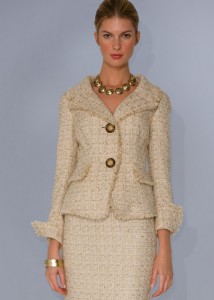 Throughout the history of fashion there has always been a distinction between patterns of clothes that are worn by different groups of people within society. Can we nowadays still speak about variations in patters between different types of people, regardless of the individualization that took place in the past decades? For over a month I have been taking various pictures of patterns from students at the Rietveld Academy in Amsterdam and from people that work for corporate organizations in the Netherlands. This research shows the results.
Throughout the history of fashion there has always been a distinction between patterns of clothes that are worn by different groups of people within society. Can we nowadays still speak about variations in patters between different types of people, regardless of the individualization that took place in the past decades? For over a month I have been taking various pictures of patterns from students at the Rietveld Academy in Amsterdam and from people that work for corporate organizations in the Netherlands. This research shows the results.
In her latest exhibition “Kutten en Lullen”, Dinie Besems shows us a collection of oddly shaped vegetables. All shapes which in some sort resemble a penis or vagina. It’s not her intention to shock us, or make us laugh, she wants to show us these weird mutations of the fruit and vegetables we eat every day. I think this project shows a lot of how Dinie Besems works. She started as a jewelry designer, at the Rietveld. But during her career she’s not afraid to cross borders, cooperate with graphic designers and other artists, and to step away from the conventional “jewelry design”.
With a bit of humor and a lot of concept she stands out among other designers. You never know which way she is going to go, but in the end it’s always something touchable, something that relates to the human body (as in jewelry).
What I noticed is that Dinie Besems often slides over into different diciplines. But in her whole oeuvre I can detect an overall interest in the communicative values of graphic design. Magazines, posters, her website and other collaborations with well known graphic designers. So where does that come from? How does she see this crossing over and are graphic design and jewelry that far apart as I thought they were?
What is special about Tichelaar Makkum porcelain? What creates the fascination of it, and what can this tell us about the world of fashion and design?
These are the questions that I will seek to answer in my research on the Royal Tichelaar Makkum porcelain factory.
Hoe kunnen de nederlandse en de moslim (arabische) bevolking dichter bij elkaar worden gebracht?
Van Benthum doet een flirt met de kleding uit arabie in zijn kleding productie RADIANT.
Ik heb gelezen dat hij zich alleen op het uiterlijk van de kleding focust maar gaat verder niet in op de diepere betekenis die hij creëert met deze connectie die hij maakt.
Door blanke jongens te laten lopen in zijn kleding geïnspireerd op Arabische klederdracht.
Deze combinatie van een Europese jongen in Arabische klederdracht doet je dan ook aan het denken zeker omdat het westen en de moslim landen steeds minder goed met elkaar overweg kunnen.
Van Benthum zijn kleding word niet gedragen op straat en deze blijft op de catwalk zelf waardoor deze kleding een mooi stuk kleding blijft maar niet gaat werken op de manier als deze ook daadwerkelijk op straat zou worden gedragen.
Op straat zou deze kleding gaan werken op een andere manier een manier waarop je mensen aan het denken zet en zich laat afragen wat doe die blanke jongen in Arabische kleding en de moslimse bevolking zou misschien een minder grote afstand voelen.
Dit zou deze twee culturen via kleding dichter bij elkaar kunnen brengen
Familie uitwisseling project.
zo zou je een Nederlandse familie uit een oer-Hollands dorp een week van kleding en huis kunnen laten ruilen met een traditionele Marokkaanse familie in Amsterdam.
deze twee families zullen voor een week van leven ruilen en zo meer begrip voor elkaar kunnen krijgen en zouden zij voor elkaar niet meer onbekenden zijn.
de Nederlandse familie zou bijvoorbeeld zo over straat lopen boodschappen doen een keer de moskee bezoeken Marokkaans eten klaarmaken en de vader moeder en kinderen zouden allemaal hun rol vervullen zoals de eigenlijke familie zou doen.
dit zelfde geld voor de Marokkaanse familie die voor een week zullen leven als deze oer Hollandse familie.
Volgens mij zal dit deze twee verschillende culturen dichter bij elkaar brengen zij zullen elkaar beter leren kennen leren begrijpen en de vervreemding van elkaar tegengaan.
At the beginning of the 20th century Josef Hoffmann, Kolo Moser and the industrialist Fritz Werndorfer founded the ‘Wiener Werkstätte’. In order to protect traditional handicraft from mass-production they designed exclusive handmade everyday objects and gave them the aura of art. At the same time they tried to find an alternative to old representative art forms favored by the rulers of Austria which shaped the picture of Vienna at this time. When they started to design architecture which they filled with their handmade furniture and their handmade objects their work became a concept that led to an idea of a different society based on pure aesthetics: they tried to create a ‘Gesamtkunstwerk’.
Under which circumstances could such a concept develop? The design of the ‘Wiener Werkstätte’ is still very modern and popular while the concept of the ‘Gesamtkunstwerk’ is not relevant anymore. But why? Do we need a similar utopia today? If one wants to get an idea ‘why’ one has to take a closer look at the development of the concept ‘Gesamtkunstwerk’ in relation to its historic background.
E.verybody L.oves Kirchner
Why should you nót love him?
Ernst Ludwig Kirchner was not just a painter or a graphic designer, as you all know him.
He was much more.
He was a man with a love for tapestry and textile design.
The good old art of weaving a tapestry, painting with wool, communication with textile.
We all have textile around us and on us but what value has it for us nowadays? Especially old folkloric textile design.
I got in e-mail contact with a textile- and tapestry designer and the fashion photographer who shot “Dutch Folklore” for Elle.
Thanks to E.L Kirchner.
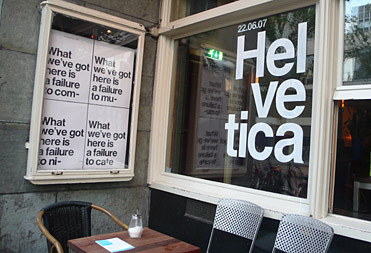
The work of graphic designers unit Experimental Jetset is often associated with the use of a very limited amount of typefaces, mostly Helvetica. Is it an easy way out, typographically? Or is using Helvetica a tribute to modernism? Now, after using Helvetica intensively for over ten years, Experimental Jetset still finds it an intriguing typeface.
However, why Helvetica?……![]() Why_Helvetica
Why_Helvetica
This research started with a very different subject; Lucas Ossendrijver, a Dutch fashion designer who’s currently working for the French high fashion brand Lanvin. What fascinated me was the big difference between his appearance and the clothing he designed! Which raised the question; why does this differ?
To be able to have an answer I started looking somewhere else; the fashion students on the Gerrit Rietveld Academy. I made a list of question I though would get the students to explore what they though would be the main difference in their own work; and I also collected photographs of the specific students and their work. This way creating a sort of almanak or small book about the fashion student and his or her clothing.
It is an ongoing project; which means that I will ask more and more students to answer these questions and collect their pictures. (I will add these to an updated version of the PDF at the bottom of this post) Like this I will create a more complete, more whole view and a more accurate answer to my question;
What’s the link between what the clothing designer wears and makes?
Lucy Sarneel (born 1961 in Maastricht) says; “In my jewellery various materials, as for instance zinc, textile, silver, gold, wood, appear. However the main metal I work in is zinc. Besides of the fact that its blue-grey color reminds me of the Dutch sea and sky it also represents the area between black and white, life and death. It refers to daily-life objects of the past like a washtub (in which my mother used to bath me when I was a toddler), a bucket or (still nowadays) a flower box.. Furthermore it associates with protection because of its use in for instance steel rooftops or rain-pipes to prevent them from rusting.
As a prominent participant in the “Gone With The Wind” exhibition held in the Zuiderzeemuseum (mrt-okt ’09), Lucy Sarneel was invited to speak about her participation in this project and one of the main themes in her work…”folklore“.
Enjoy the series of images in which it becomes apparent how the spirit of form and function can be translated into inspiring contemporary mixed media jewelery.
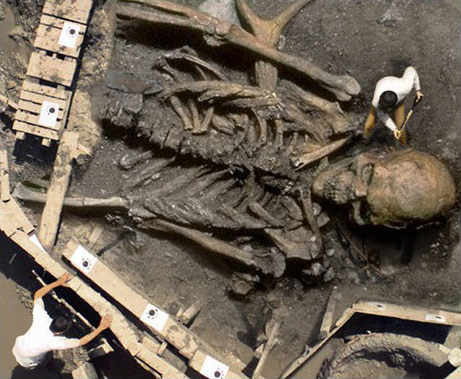
“giant skeleton found during excavation”
The picture above was initially made for a contest on photo manipulation, but once it was free on the net, there were immediate claims of it being real (partly supported by some religions that believe human beings were once giants).
Hundreds of hoax images like this circulate the Internet daily and, when they possess one or more elements of credibility and reach a group of people inclined to believe them due to a religious, political or moral standpoint, a certain hype around them will be created and our mailboxes will be invaded by more spam.
This phenomenon is characteristic of our times and is a part of our common knowledge, being thus also a part of our modern folklore.
The work of Dutch artists can often be easily recognized among works of other artist. Dutch labels like Droog Design, Victor&Rolf, Orson+Bodil from Alexander van Slobbe, Inez van Lamswerde and also Wendelien Daan have this “Dutch signature.” According to different sources; photographers, magazines and models, the cause of this difference is the way Dutch artist work. Wendelien Daan fits in this thought about a “Dutch signature”. Her pictures of high fashion for big international magazines consist a lot of darkness, are high in contrast and minimalist. She lights her images as natural as possible. But what is this “Dutch signature” exactly? And how come most of us in the Netherlands seem to work this way? Is it something we’ve learned at school, are we raised this way or is it part of our folklore? We definitely have a different way of working than American artists. We have less taboos. However, the biggest international platform for artist is America. Why?